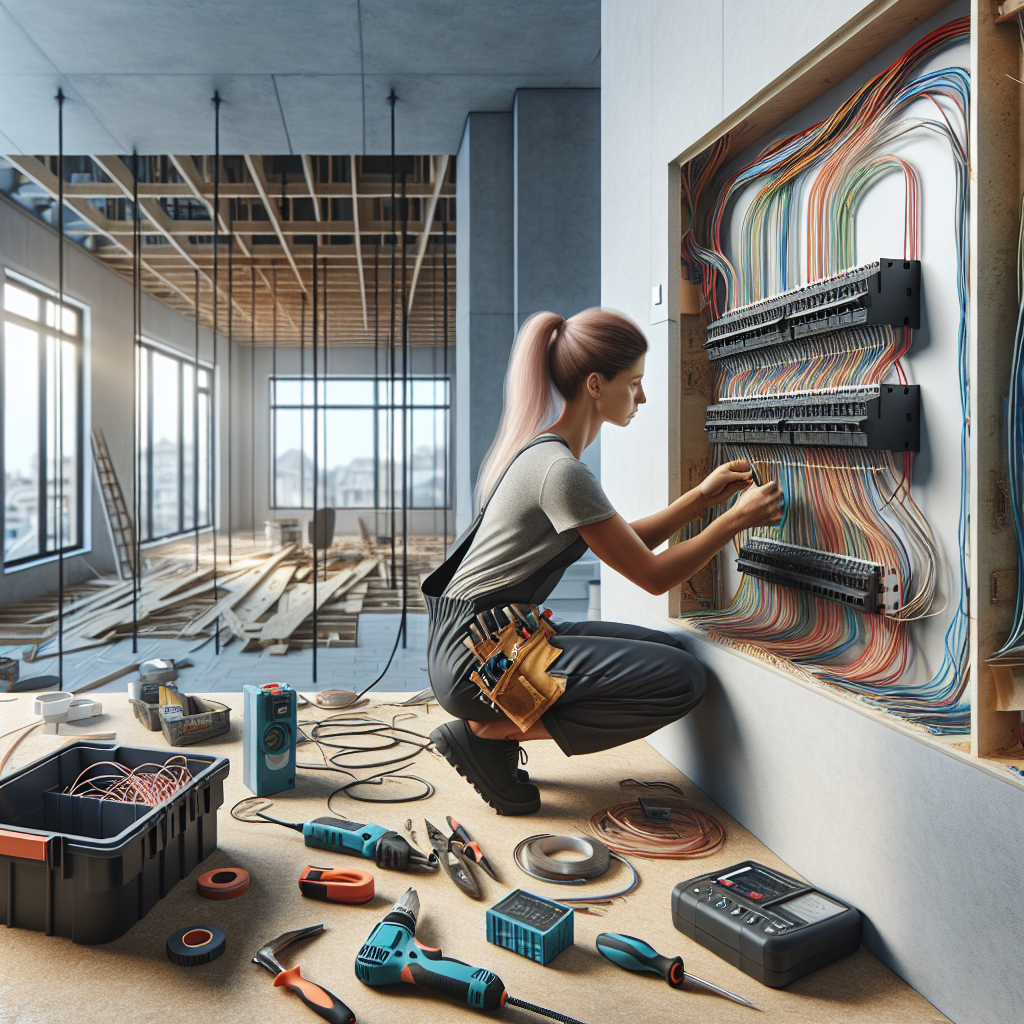If you’re considering modernizing your home to meet today’s electrical demands, understanding the importance of home rewiring is crucial. As technology advances and we accumulate more electronic devices, the electrical systems in many older homes struggle to keep up. This can lead to not only inefficiency but also serious safety risks. In this article, we will guide you through the essentials of rewiring your home, helping you ensure that your living space is both safe and capable of supporting modern electrical needs. With BuildNet’s expert advice, tackling this significant home improvement project will feel less daunting.
Understanding the Importance of Home Rewiring for Modern Electrical Demands
Many homes built more than 30 years ago weren’t designed with today’s electrical consumption in mind. From high-definition televisions to smart home devices, the demand for power can significantly surpass what your home’s electrical system was designed to handle. Rewiring not only updates your home to handle these modern devices but also enhances your family’s safety by reducing the risk of electrical fires and other hazards associated with outdated electrical systems.
Step-by-Step Guide to Rewiring Your Home: What Homeowners Should Know
Embarking on a home rewiring project can seem overwhelming. However, with a clear understanding of the steps involved, homeowners can approach this task with confidence. This guide will walk you through the necessary preparations, the actual rewiring process, and what to consider after the work is completed to ensure everything is up to standard.
Choosing the Right Professional for Your Home Rewiring Project: Tips and Best Practices
Selecting the right contractor is pivotal to the success of your rewiring project. We’ll provide tips on how to find qualified, reliable professionals and best practices for working with them. From verifying licenses and references to understanding quotes and contracts, we’ll help you make informed decisions that lead to a smooth, successful home improvement experience.

If you’re ready to take your home improvement or construction project to the next level, we can help! Find trusted contractors on BuildNet, whether you’re looking for renovations, new builds, electrical work, plumbing, or anything in between. Our directory connects you with qualified professionals who can make your vision a reality.
Understanding the Importance of Home Rewiring for Modern Electrical Demands
Hey there, homeowner! You might be wondering why there’s so much buzz around home rewiring. Well, let me guide you through this electrifying journey to understand why it’s crucial, especially in our modern world where our electrical demands are skyrocketing!
Why Consider Rewiring Your Home?
First things first, let’s talk about why rewiring your home could be one of the best decisions you might make:
- Safety First: Old wiring isn’t just ineffective; it’s dangerous. Frayed or outdated wires are fire hazards lurking behind your walls. Rewiring reduces the risk of electrical fires significantly.
- Meet Modern Needs: Today, we’re using more gadgets and appliances than ever before, from smartphones to smart fridges. Older homes weren’t built for such loads. Rewiring helps ensure that your electrical system can handle these increased demands safely.
- Future-proof Your Home: Whether it’s electric vehicles or the latest in home automation, technology is advancing rapidly. Having a modern electrical system means you’re ready for whatever tech throws your way.
- Value Addition: Rewiring can be a fantastic selling point if you’re considering putting your house on the market. It assures potential buyers that they won’t have to face electrical issues.
The Risk of Overloading Your Current Electrical System
Let’s paint a picture here. Imagine your home is like a cup and electricity is water. If your cup is too small and you keep adding water, what happens? It spills over! Similarly, when your home’s electrical system is outdated, adding more and more modern appliances can lead to ‘spillage’, or in electrical terms, overloading. This can cause circuit breakers to trip and, in extreme cases, might even lead to fires.
Recognizing the Signs of an Overloaded Electrical System
Here are a few red flags that signal your system might be overwhelmed:
- Flickering or dimming lights when other appliances are used.
- Breakers that frequently trip.
- Outlets that feel warm to the touch or emit a burning smell.
- Sudden shutdowns of major appliances.
If you’re noticing any of these symptoms, it might be time to think about rewiring. It’s not just about convenience; it’s about safety.
Energy Efficiency and Eco-Friendly Homes
Did you know that rewiring could also mean savings on your energy bills? Modern electrical systems and wiring are more efficient at conducting electricity, and when paired with energy-efficient appliances, the impact on your energy consumption can be significant.
Additionally, energy-efficient homes are good for the planet. By reducing your energy use, you’re also reducing your carbon footprint. It’s a win-win!
Enhancing Your Home’s Functionality and Aesthetics
Rewiring also offers a great opportunity to upgrade other elements of your home. Planning for additional outlets where you need them, or perhaps finally getting those outdoor lights installed, can significantly enhance the functionality and aesthetics of your space.
Imagine this: no more extension cords snaking across the floor because you’ve got outlets right where you need them. Or perhaps, finally having the right connections to install that home theatre system you’ve been dreaming about.
Local Regulations and Safety Codes
One critical aspect that cannot be overlooked is adhering to local regulations and safety codes. These guidelines are not just bureaucratic red tape; they are crafted to ensure your safety. Each region might have specific requirements based on environmental factors and historical data, so understanding and complying with these regulations is crucial.
For instance, in areas prone to electrical storms or earthquakes, there might be stringent rules about how and where to install certain components of your electrical system. Ensuring your rewiring project meets these standards is essential not just for safety, but for your insurance and resale value as well.
Final Thoughts
So, whether you’re a tech enthusiast wanting to future-proof your home, a green warrior aiming to reduce your environmental impact, or simply a concerned homeowner looking out for the safety and efficiency of your abode, rewiring ticks all these boxes.
Every home’s needs are different, and the complexities of rewiring can vary widely. It’s about making your home safe, efficient, and ready for the demands of modern living. If you’re seeing signs that your home might need rewiring, considering the potential benefits, or just want to be proactive about electrical safety, rewiring might just be what your home needs.

Step-by-Step Guide to Rewiring Your Home: What Homeowners Should Know
Hey there! Thinking about rewiring your home? It might seem like a daunting task, but with the right information and a bit of planning, it can be a smooth process. Whether you’re dealing with flickering lights or you’re planning major home upgrades, rewiring your home is crucial for safety and efficiency. Let’s dive into a step-by-step guide that will help you understand what’s involved and how to make it happen without too many hiccups.
Step 1: Understand Why You Need Rewiring
First things first – why are you rewiring? Older homes often can’t handle the electrical load of modern high-demand appliances like microwaves, dishwashers, and computers. Plus, outdated wiring can be a safety hazard. Recognizing the signs that you need rewiring is crucial and includes frequent circuit breaker trips, buzzing sounds from outlets, or a persistent burning smell.
Step 2: Plan Your Project
- Assess Your Needs: Consider what appliances you use, plan for home additions, and think about future technology needs.
- Get a Home Inspection: Hire a licensed electrician to inspect your current system and identify what needs to be updated.
- Create a Rewiring Blueprint: This will include the locations of all outlets, switches, and major appliances.
Step 3: Choose Your Materials
When choosing materials, go for quality and durability. Your electrician can help you decide on the best type of wiring, outlets, and additional components like surge protectors and GFCI outlets, which are crucial for safety in areas exposed to moisture.
Step 4: Obtain Necessary Permits
Before the work begins, it’s essential to obtain the necessary local permits. These regulations vary by location, so check with your local building department to avoid any legal issues. Permits ensure that rewiring work is up to code, reducing risks associated with electrical work.
Step 5: Preparation for the Rewiring Process
- Clear the Area: Provide clear access to walls and ceilings by moving furniture and valuables.
- Safety Measures: Safety is paramount. Make arrangements to stay somewhere else if the power needs to be off for an extended period.
Step 6: The Rewiring Process
The actual rewiring process involves removing old wires and installing new ones, connecting new outlets and switches, and integrating the system with your circuit breaker. This process can be invasive, as it may require cutting into walls and ceilings.
Running New Wires
New wires are typically run through walls, in the attic, or under the floor. Your electrician will likely use a method that minimizes damage to your home’s structure.
Installing Outlets and Switches
New outlets and switches will replace old ones, and additional ones can be added to suit your needs. This is a good time to consider the placement based on convenience and functionality.
Step 7: Testing and Quality Assurance
After installation, your electrician should test the system thoroughly to ensure everything is working correctly and safely. This includes checking each outlet, ensuring all switches function as intended, and confirming that there are no potential hazards.
Step 8: Cleanup and Final Inspection
Once the testing is completed, any openings in the walls and ceilings used to run the new wiring should be repaired. It’s important that your home is left in its original condition, or better. Finally, a final inspection by the authorities may be required to close out the permits.
Additional Tips for a Successful Rewiring Project
- Stay Involved: Keep in communication with your electrician to stay informed about the project’s progress and any issues that arise.
- Future Proofing: Consider future needs like smart home devices or electric vehicle chargers. It’s cheaper to do it now than to upgrade later.
- Choose a Reputable Electrician: This can’t be overstated. A certified and experienced electrician is crucial for a safe and effective rewiring project.
Remember, while rewiring your home is a significant undertaking, it’s also a worthwhile investment in your property’s safety and functionality. With careful planning, the right team, and a clear understanding of the steps involved, you’ll be powering your home more efficiently and safely in no time. Good luck!
Choosing the Right Professional for Your Home Rewiring Project: Tips and Best Practices
Welcome to the essential guide on selecting the perfect professional for your home rewiring project! If you’re contemplating rewiring your home, you’re already aware of the complexity and importance of this task. However, the key to a successful rewiring job lies in finding the right electrician. It’s not just about getting the job done, but ensuring it’s done safely, efficiently, and up to code. So, let’s dive into the insights and tips that will help you navigate the process of finding the best professional for this critical job.
Understanding the Credentials: What to Look for in a Professional
When it comes to electrical work, particularly something as comprehensive as rewiring your home, the qualifications and credentials of your electrician cannot be overlooked. First and foremost, ensure that the electrician is licensed. Licensing ensures that the professional has met the necessary educational and practical requirements to perform electrical work safely and correctly.
Apart from licensing, it’s beneficial to check if they are insured and bonded. Insurance protects you from any liabilities in case of accidents, while bonding protects you in case of a breach of contract. Also, look for certifications from reputable bodies like the National Electrical Contractors Association (NECA) or the Independent Electrical Contractors (IEC) which add another layer of credibility to their expertise.
Experience Matters: Assessing Expertise
Experience is an invaluable asset in electrical work. An electrician with extensive experience in rewiring homes is likely to be more adept at solving complex problems and can provide insights into the best practices for your particular situation. Ask potential candidates about the number of years they’ve been in business and the types of homes they have worked on, especially homes similar to yours in age and structure.
Don’t hesitate to ask for case studies or references. A reputable electrician won’t shy away from showcasing their past work or connecting you with previous clients. This can provide you with a clearer idea of their capability and the quality of their workmanship.
Comparing Quotes: What’s Fair and What’s Not?
Obtaining multiple quotes is more than just about finding the lowest price. It’s about understanding what’s included in the service, the quality of the materials used, and the projected timelines. When reviewing quotes, ensure they are detailed and include a breakdown of costs for labor, materials, and any additional fees. This transparency not only helps prevent misunderstandings but also provides an insight into how thorough the electrician is.
Be wary of quotes that seem too good to be true. Exceptionally low bids might indicate that the electrician might cut corners or use inferior quality materials. On the flip side, very high quotes should have justifiable reasons attached, such as additional services or higher-grade materials.
Communication is Key: Evaluating Professionalism and Approachability
The importance of effective communication cannot be overstressed. During the initial consultation, notice how the electrician explains the scope of the project. They should be able to articulate what needs to be done in a way that is understandable to you. This not only shows their knowledge but also their willingness to ensure you are informed about the process.
A professional electrician will always appear approachable, ready to address your concerns, and willing to provide explanations. This is crucial because rewiring a home can sometimes require decision-making on the fly, and you need someone who can collaborate with you and respect your choices.
Local Insights: Why Choosing Locally Can Be a Game-Changer
Opting for a local electrician can offer numerous advantages. They are likely to be more accessible and can respond quicker to your needs. Moreover, local professionals understand the specific wiring standards and building codes of your area, reducing the risk of non-compliance. Plus, hiring within your community supports local businesses and keeps the local economy thriving.
To find a reputable local electrician, start by asking for recommendations from friends or family who have had similar work done. You can also check local business directories and read online reviews to get a sense of the electrician’s reputation in the community.
In conclusion, choosing the right professional for your home rewiring is not just about finding someone who can do the job, but finding someone who can do the job right. By focusing on their credentials, experience, the detail in their quotes, communication skills, and opting for local talent, you’re setting the stage for a successful home rewiring project that will serve your household well for many years to come. Remember, a well-chosen electrician not only ensures the safety of your home but also adds value to it.

Why is home rewiring important for modern electrical demands?
Rewiring your home is essential to handle today’s high-tech appliances and gadgets. Older homes were not designed to support numerous devices running simultaneously, which can lead to overloaded circuits and potential hazards like electrical fires. Rewiring ensures that your electrical system is safe, efficient, and compliant with current codes, ultimately improving energy management and reducing the risk of electrical issues.
What are the signs that my home needs rewiring?
Several indicators suggest it might be time to consider rewiring your home:
- Frequent tripping of circuit breakers or blown fuses
- Discolored or charred outlets and switches
- A persistent burning smell from appliances or in rooms
- Flickering or dimming lights
- Outdated aluminum wiring, prevalent in homes built before the 1970s
How often should a home be rewired?
There isn’t a one-size-fits-all answer, but experts recommend inspection and potential rewiring for homes over 40 years old, especially if modern appliances are in heavy use. Routine checks every 10 years can help identify potential issues before they become serious problems.
What should I expect during the home rewiring process?
Rewiring a home involves several key steps:
- **Planning**: Assessment of your current electrical system and designing a new system that meets modern standards.
- **Permitting**: Acquiring necessary local permits to ensure the work is compliant with building codes.
- **Installation**: Replacing old wires with new copper wiring, updating outlets, and possibly upgrading your electrical panel.
- **Testing**: Ensuring all new wiring is safe and functional.
Expect some disruption in your home during this time, as walls may need to be accessed and power may be intermittent.
How do I choose the right professional for my home rewiring project?
Choosing the right contractor is crucial. Look for licensed, insured professionals with strong reviews and a track record of handling similar projects. It’s important to get multiple quotes and check references to ensure you’re choosing someone reputable and within your budget.
Can I do any part of the rewiring myself to save costs?
DIY electrical work is not recommended due to the high risk of injury and potential code violations. Always hire a certified electrician. However, you can save costs by preparing your home for the professionals, like moving furniture and ensuring clear access to work areas.
What are the long-term benefits of rewiring my home?
Rewiring comes with several long-term benefits:
- Increased safety by reducing the risk of electrical fires and accidents
- Enhanced capacity to support modern appliances and technology
- Possibly increased home value, as prospective buyers value safety and modern upgrades
- Better energy efficiency, which can reduce utility bills
Conclusion
If you’re noticing any signs of electrical issues or if your home is reaching that 40-year mark, it might be time to consider rewiring. This process not only ensures your family’s safety but also adapts your home for modern appliances and can even boost your home’s market value. Remember, while the upfront cost might seem daunting, the peace of mind and long-term savings are well worth the investment.
Choosing the right professional is key to a successful rewiring project. At BuildNet, we connect you with trusted, skilled contractors who have been vetted for quality and reliability. Don’t hesitate to visit our website and contact a contractor for a free quote. Ensure your home is safe and capable of meeting the demands of modern electrical consumption with a proper rewiring project.







